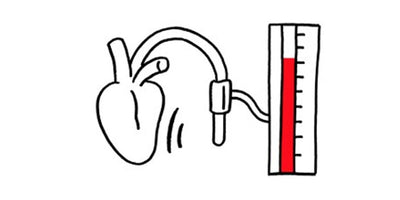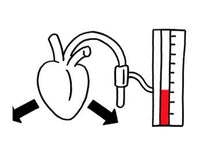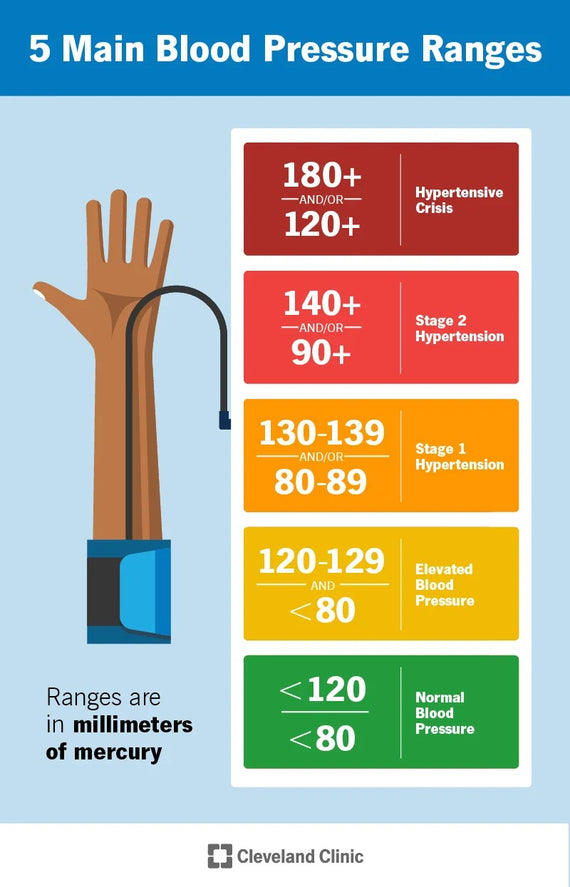What is Blood Pressure?

Systole (heart value):

Diastole (vessel value):
It measures the pressure at the moment the heart relaxes, i.e. when the heart fills with blood again.
Clinically Proven
Technical Team
Lifetime Warranty
FSA/HSA Eligible
Understanding
Irregular heartbeat detection:
Symptoms such as skipped or premature heartbeats, a slow or fast pulse, can stem from factors like heart disease, age, genetics, stress. Arrhythmia can only be diagnosed by a medical professional.
Should the symbol appear after a measurement, we recommend repeating the process. Ensure a 5-minute rest period without speaking or movement before the measurement. If the symbol appears often, please contact your doctor.

Meet our newest BPM Line

Auto 400
Upper Arm
• Universal cuff (8.7 - 16.5 in)
• 60 Memory spaces
• Risk indicator
• Irregular heartbeat
• 1 User

Deluxe 600
Upper Arm
• Universal cuff (8.7 - 16.5 in)
• 180 Memory spaces
• Risk indicator
• Irregular heartbeat
• 2 Users
• Bluetooth: Compatible with HealthManager Pro App

Premium 800
Upper Arm
• Universal cuff (8.7 - 16.5 in)
• 240 Memory spaces
• Talking Function
• Irregular Heartbeat
• Bluetooth: Compatible with HealthManager Pro App

Premium 800W
Wrist
• Universal cuff (5.3 - 8.5 in)
• 120 Memory spaces
• Risk indicator
• Irregular Heartbeat
• Bluetooth: Compatible with HealthManager Pro App
Leader in Technology

HealthManager Pro
App

Designed & Engineered
in Germany
What Can Cause Hypertension (High Blood Pressure)?
Pregnancy
Age

Tobacco & Alcohol
Physical Inactivity

Pregnancy
Age
Tobacco & Alcohol
How do you know if you have high blood pressure?
High blood pressure, also known as hypertension, is typically defined as a systolic blood pressure (the top number) of 140 mmHg or higher, or a diastolic blood pressure (the bottom number) of 90 mmHg or higher. Some signs of hypertension can include headaches, fatigue, nosebleeds, and difficulty breathing, but these symptoms are not always present and are not specific to hypertension. It is important to have your blood pressure checked regularly, and talk to your doctor if you have any concerns.

Frequently Asked Questions
-
1
How do I properly measure my blood pressure?
1. Sit in a comfortable, upright position with your back supported and your feet flat on the floor.
2. Place the blood pressure cuff on your bare upper arm, with the cuff's lower edge about 1 inch above the bend of your elbow.
3. The cuff should be snug but not tight. Make sure that the bottom of the cuff is level with the center of your heart.
4. Rest for at least 5 minutes before taking your blood pressure. Avoid smoking, drinking caffeine, or exercising for at least 30 minutes before taking your blood pressure. Press the "start" button on the blood pressure monitor.
5. The cuff will automatically inflate and begin measuring your blood pressure.
6. Do not talk or move during the measurement.
7. Once the measurement is complete, the monitor will display your systolic and diastolic blood pressures and heart rate. -
2
What is the best time to measure my blood pressure?
Morning: Blood pressure tends to be at its lowest in the morning, after a night's sleep. It is recommended to measure your blood pressure in the morning before breakfast or engaging in any activities.
Afternoon: Blood pressure tends to rise throughout the day, so measuring it in the afternoon can give you a sense of how your blood pressure changes over the course of a day.
Evening: Blood pressure tends to be at its highest in the evening, after a day of activities. Measuring it at night can help you understand how your daily habits and routines affect your blood pressure. -
3
Why do I get different readings at home than at the doctor's office?
There are a few reasons why you may get different blood pressure readings at home compared to those taken by a healthcare professional:
1. White coat hypertension: This is a phenomenon where blood pressure tends to be higher when taken in a clinical setting, such as a doctor's office, due to the stress and anxiety of being in a medical environment.
2. Technique: Blood pressure readings can be affected by the technique used to measure it. If the cuff is not properly positioned on your arm, or if you are not sitting correctly, the reading may be inaccurate.
3. Equipment: Blood pressure monitors can vary in accuracy, so even small differences in equipment can lead to different readings.
4. Environment: Blood pressure can be affected by external factors such as ambient temperature, noise levels, and time of day.
5. Medications: Some medications can affect blood pressure, so if you take any medications, it's important to let your healthcare provider know so they can take that into account when measuring your blood pressure. -
4
Is an upper arm monitor more accurate than wrist?
Both types of monitors can be accurate, but there are some differences to consider when choosing between them.Upper Arm: considered to be the most accurate type of home blood pressure monitors. These monitors are generally larger and more complex than wrist monitors, but they are more accurate and reliable.Wrist: These kinds of monitors are equally acuurate, however, the position of the wrist during measurement can also affect the accuracy of the reading. The American Heart Association recommends that wrist monitors should be positioned at the same level as the heart, which can be difficult to achieve when using a wrist monitor. -
5
How often should I measure my blood pressure?
It's a good idea to measure your blood pressure on a regular basis, such as once a week or once a month. However, it's important to keep in mind that blood pressure can fluctuate throughout the day, so it's best to measure it at different times of the day to get an accurate picture of your blood pressure. -
6
How tight should the cuff be when taking a blood pressure reading?
The cuff should be snug but not tight. It should be positioned on the bare upper arm, with the cuff's lower edge about 1 inch above the bend of your elbow. -
7
What should I do if my blood pressure is high?
If your blood pressure is consistently high, it's important to consult with your healthcare provider. They may recommend lifestyle changes, such as diet and exercise, and/or medication to help lower your blood pressure. -
8
Should I be concerned if my blood pressure fluctuates?
Some fluctuation in blood pressure is normal. However, if your blood pressure is consistently high or if you notice a significant change in your blood pressure, it's important to consult with your healthcare provider. -
9
What does resting indicator mean?
A resting indicator on a blood pressure monitor is a feature that indicates whether or not the person being monitored is in a relaxed state, which is necessary for an accurate blood pressure reading. -
10
What does position indicator mean?
A cuff position indicator on a blood pressure monitor is a feature that helps the user to properly position the cuff on the arm to ensure an accurate blood pressure reading.

Hypertension - What is It?

High blood pressure is defined as a systolic blood pressure of 140 mmHg and a diastolic value of 90 mmHg. The heart and blood vessels change as a result of the increased blood pressure: the heart muscle thickens the vessels become less elastic and more prone to wear. These heart and vascular changes precede many serious diseases - for example heart attacks, cardiac insufficiency or strokes.
In most cases, an unhealthy lifestyle is responsible for high blood pressure. This includes:
- Wrong and unhealthy diet
- Overweight
- Lack of exercise
-Stress
-Alcohol
-Nicotine
-Sleep apnea
-Increased salt consumption
Lifestyle changes can often lower blood pressure. These include, for example, reducing obesity and stress, switching to a healthy diet and getting enough exercise, as well as not consuming alcohol and nicotine.
Nathan Mckinney
Even a slight drop in blood pressure of 5 mmHg can prevent consequential damage:
- The risk of a stroke decreases by up to 14%.
- The heart attack risk drops by up to 9%.
High blood pressure often does not cause any symptoms for many years and therefore initially remains undetected. Many feel comfortable with high blood pressure for years and have no symptoms. High blood pressure is then usually discovered by accident at the doctor's - often after it has already left traces in the body.
The only sure way to spot high blood pressure early is to measure blood pressure regularly, even when there are no symptoms.
Nathan Mckinney

What is Blood Pressure?

Wrist or Upper Arm Monitor?
Director



